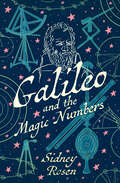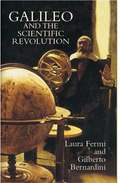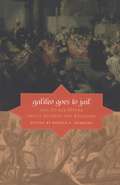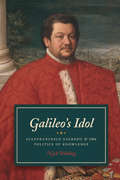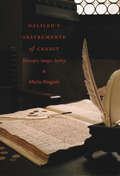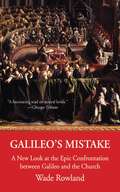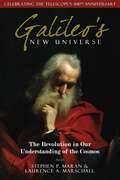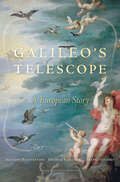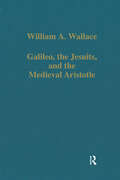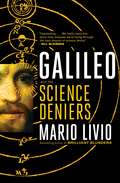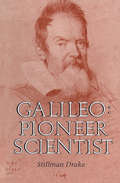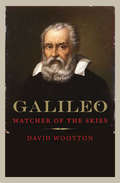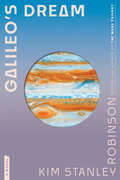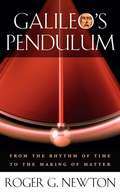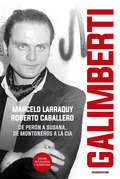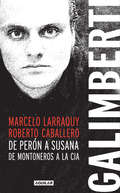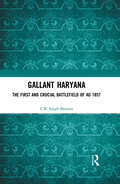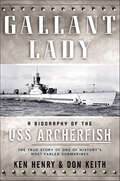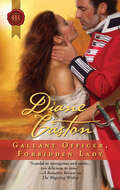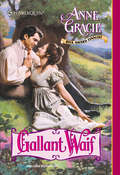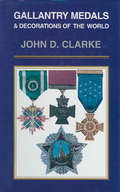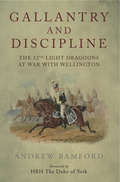- Table View
- List View
Galileo and the Magic Numbers
by Sidney RosenThis &“enjoyable&” biography of the brilliant astronomer will intrigue young people who are &“bored with the textbook approach to science&” (The New York Times Book Review). Sixteenth century Italy produced Galileo, a genius who marked the world with his studies and hypotheses about mathematical, physical, and astronomical truths. His father, musician Vincenzio Galilei said, &“Truth is not found behind a man&’s reputation. Truth appears only when the answers to questions are searched out by a free mind. This is not the easy path in life but it is the most rewarding.&” Galileo challenged divine law and the physics of Aristotle, and questioned everything in search of truths. And it was through this quest for truth that he was able to establish a structure for modern science.
Galileo and the Scientific Revolution
by Laura Fermi Gilberto BernardiniAn absorbing account of the origins of modern science as well as a biography of the revolutionary thinker, this inspiring book was co-written by a former director of the Italian Institute for Nuclear Physics and a historian of science (who was also the wife of physicist Enrico Fermi). It begins in Galileo's youth, with his return to his native city of Pisa to train as a physician. Instead, the student became captivated by the power of mathematical reasoning — an interest that led him to apply mathematical logic to natural events and, ultimately, to invent the concept of experimentation. Galileo's progress from student to teacher to scientific innovator is traced, with particular emphasis on his experiments with building and refining telescopes and his unprecedented observations of the moon and planets. The dramatic results of his findings, including his refutation of Aristotelian theory and his support of Copernican doctrine, are related in full, along with his clash with the papal inquisition and his tragic demise under house arrest. Written with a warm appreciation for the wonders of Galileo's achievements and with impeccable scholarship, this book concludes with a survey of the scientist's remarkable legacy. 12 figures. Appendix. Bibliography. Index.
Galileo goes to Jail and other Myths about Science and Religion
by Ronald L. NumbersA new generation of historians both of science and of the church began to examine episodes in the history of science and religion through the values and knowledge of the actors themselves. Now Ronald Numbers has recruited the leading scholars in this new history of science to puncture the myths, from Galileo's incarceration to Darwin's deathbed conversion to Einstein's belief in a personal God who didn't play dice with the universe.
Galileo's Idol: Gianfrancesco Sagredo & the Politics of Knowledge
by Nick WildingGalileo’s Idol offers a vivid depiction of Galileo’s friend, student, and patron, Gianfrancesco Sagredo (1571–1620). Sagredo’s life, which has never before been studied in depth, brings to light the inextricable relationship between the production, distribution, and reception of political information and scientific knowledge. Nick Wilding uses as wide a variety of sources as possible—paintings, ornamental woodcuts, epistolary hoaxes, intercepted letters, murder case files, and others—to challenge the picture of early modern science as pious, serious, and ecumenical. Through his analysis of the figure of Sagredo, Wilding offers a fresh perspective on Galileo as well as new questions and techniques for the study of science. The result is a book that turns our attention from actors as individuals to shifting collective subjects, often operating under false identities; from a world made of sturdy print to one of frail instruments and mistranscribed manuscripts; from a complacent Europe to an emerging system of complex geopolitics and globalizing information systems; and from an epistemology based on the stolid problem of eternal truths to one generated through and in the service of playful, politically engaged, and cunning schemes.
Galileo's Instruments of Credit: Telescopes, Images, Secrecy
by Mario BiagioliIn six short years, Galileo Galilei went from being a somewhat obscure mathematics professor running a student boarding house in Padua to a star in the court of Florence to the recipient of dangerous attention from the Inquisition for his support of Copernicanism. In that brief period, Galileo made a series of astronomical discoveries that reshaped the debate over the physical nature of the heavens: he deeply modified the practices and status of astronomy with the introduction of the telescope and pictorial evidence, proposed a radical reconfiguration of the relationship between theology and astronomy, and transformed himself from university mathematician into court philosopher.Galileo's Instruments of Credit proposes radical new interpretations of several key episodes of Galileo's career, including his early telescopic discoveries of 1610, the dispute over sunspots, and the conflict with the Holy Office over the relationship between Copernicanism and Scripture. Galileo's tactics during this time shifted as rapidly as his circumstances, argues Mario Biagioli, and the pace of these changes forced him to respond swiftly to the opportunities and risks posed by unforeseen inventions, further discoveries, and the interventions of his opponents. Focusing on the aspects of Galileo's scientific life that extend beyond the framework of court culture and patronage, Biagioli offers a revisionist account of the different systems of exchanges, communication, and credibility at work in various phases of Galileo's career. Galileo's Instruments of Credit will find grateful readers among scholars of science studies, historical epistemology, visual studies, Galilean science, and late Renaissance astronomy.
Galileo's Mistake: A New Look at the Epic Confrontation between Galileo and the Church
by Wade RowlandThe modern understanding of the notorious 1633 trial of Galileo is that of Science and Reason persecuted by Ignorance and Superstition-of Galileo as a lonely, courageous freethinker oppressed by a reactionary and anti-intellectual institution fearful of losing its power and influence. But is this an accurate picture? In his provocative reexamination of one of the turning points in the history of science and thought, Wade Rowland contends that the dispute concerned an infinitely more profound question: What is truth and how can we know it? Rowland demonstrates that Galileo's mistake was to insist that science-and only science-provides the truth about reality. The Church rejected this idea, declaring that while science is valid, truth is a metaphysical issue-beyond physics-and it involves such matters as meaning and purpose, which are unquantifiable and therefore not amenable to scientific analysis. In asserting the primacy of science on the territory of truth, Galileo strayed into the theological realm, an act that put him squarely on a warpath with the Church. The outcome would change the world. Wade Rowland's thoughtful exploration promises to disarm the most stubborn of skeptics and make for scintillating debate.
Galileo's New Universe: The Revolution in Our Understanding of the Cosmos
by Stephen P. Maran Laurence A. MarschallThe historical and social implications of the telescope and that instrument's modern-day significance are brought into startling focus in this fascinating account. When Galileo looked to the sky with his perspicillum, or spyglass, roughly 400 years ago, he could not have fathomed the amount of change his astonishing findings-a seemingly flat moon magically transformed into a dynamic, crater-filled orb and a large, black sky suddenly held millions of galaxies-would have on civilizations. Reflecting on how Galileo's world compares with contemporary society, this insightful analysis deftly moves from the cutting-edge technology available in 17th-century Europe to the unbelievable phenomena discovered during the last 50 years, documenting important astronomical advances and the effects they have had over the years.
Galileo's Telescope: A European Story
by Massimo BucciantiniBetween 1608 and 1610 the canopy of the night sky changed forever, ripped open by an object created almost by accident: a cylinder with lenses at both ends. Galileo's Telescope tells the story of how an ingenious optical device evolved from a toy-like curiosity into a precision scientific instrument, all in a few years. In transcending the limits of human vision, the telescope transformed humanity's view of itself and knowledge of the cosmos. Galileo plays a leading-but by no means solo-part in this riveting tale. He shares the stage with mathematicians, astronomers, and theologians from Paolo Sarpi to Johannes Kepler and Cardinal Bellarmine, sovereigns such as Rudolph II and James I, as well as craftsmen, courtiers, poets, and painters. Starting in the Netherlands, where a spectacle-maker created a spyglass with the modest magnifying power of three, the telescope spread like technological wildfire to Venice, Rome, Prague, Paris, London, and ultimately India and China. Galileo's celestial discoveries-hundreds of stars previously invisible to the naked eye, lunar mountains, and moons orbiting Jupiter-were announced to the world in his revolutionary treatise Sidereus Nuncius. Combining science, politics, religion, and the arts, Galileo's Telescope rewrites the early history of a world-shattering innovation whose visual power ultimately came to embody meanings far beyond the science of the stars.
Galileo, the Jesuits, and the Medieval Aristotle (Variorum Collected Studies)
by William A. WallaceThe conventional opposition of scholastic Aristotelianism and humanistic science has been increasingly questioned in recent years, and in these articles William Wallace aims to demonstrate that a progressive Aristotelianism in fact provided the foundation for Galileo's scientific discoveries. The first series of articles supply much of the documentary evidence that has led the author to the sources for Galileo's early notebooks: they show how Galileo, while teaching or preparing to teach at Pisa, actually appropriated much of his material from Jesuit lectures given at the Collegio Romano in 1598-90. The next articles then trace a number of key elements in Galileo's later work, mainly relating to logical methodology and natural philosophy, back to sources in medieval Aristotelian thought, notably in the writings of Albert the Great and Thomas Aquinas. La mise en opposition conventionnelle entre l’aristotélisme scolastique et la science humaniste a été de plus en plus remise en question durant les dernières années. Tout au long de ces articles, William Wallace tente de démontrer que l’aristotélisme progressif a en fait pourvu le fondement des découvertes scientifiques de Galilée. Le premier groupe d’articles fournit la plupart des preuves documentées qui ont mené l’auteur aux sources des premiers cahiers de notes de Galilée; on y voit comment celui-ci, alors qu’il enseignait, ou s’apprêtait à enseigner à Pise, s’était en fait approprié quantité de donneés issues de cours magistraux jésuites qui avaient été donnés au Collegio Romano entre 1588 et 90. Les études suivantes retracent à leur tour un certain nombre d’elements-clef des travaux ultérieurs de Galilée, se rapportant plus particulièrement à la méthodologie logique et a la philosophie naturelle, jusqu’à leurs sources dans la pensée aristotélicienne du Moyen Age, notamment dans les écrits d’Albert le Grand et de Thomas d’Aquin.
Galileo: And the Science Deniers
by Mario LivioA fresh interpretation of the life of Galileo Galilei, one of history&’s greatest and most fascinating scientists, that sheds new light on his discoveries and how he was challenged by science deniers. &“We really need this story now, because we&’re living through the next chapter of science denial&” (Bill McKibben).Galileo&’s story may be more relevant today than ever before. At present, we face enormous crises—such as the minimization of the dangers of climate change—because the science behind these threats is erroneously questioned or ignored. Galileo encountered this problem 400 years ago. His discoveries, based on careful observations and ingenious experiments, contradicted conventional wisdom and the teachings of the church at the time. Consequently, in a blatant assault on freedom of thought, his books were forbidden by church authorities. Astrophysicist and bestselling author Mario Livio draws on his own scientific expertise to provide captivating insights into how Galileo reached his bold new conclusions about the cosmos and the laws of nature. A freethinker who followed the evidence wherever it led him, Galileo was one of the most significant figures behind the scientific revolution. He believed that every educated person should know science as well as literature, and insisted on reaching the widest audience possible, publishing his books in Italian rather than Latin. Galileo was put on trial with his life in the balance for refusing to renounce his scientific convictions. He remains a hero and inspiration to scientists and all of those who respect science—which, as Livio reminds us in this gripping book, remains threatened even today.
Galileo: Pioneer Scientist
by Stillman DrakeSince publication of Stillman Drake?s landmark volume, Galileo at Work: His Scientific Biography, new and exciting information has come to light about this towering figure in the history of Western science. Drawing largely from Galileo?s manuscript working papers, Drake now adds a wealth of detail to the story. Among the findings he presents in this volume are the steps that led to discovery of the pendulum law and the law of fall, by which Galileo opened the road to modern physics; Galileo?s path to the new astronomy of Copernicus, closely linked to his first essays in physics; his subsequent misgivings and final reassurances provided by the telescope. Drake focuses on Galileo?s pioneering work in physics, previously unknown, and shows that time has not diminished its value. He also considers some of the factors that played a part in the development of physics, its classical Greek beginnings, the medieval interlude, the contribution of some of Galileo?s contemporaries, and the resistance of others to his new science of motion. We see in a new light the relation of that science to modern dynamics, created by Newton half a century later. Galileo is better known as an astronomer than as a modern physicist. Drake sheds new light here too as he explores Galileo?s pioneer invention of satellite astronomy, his sighting of Neptune two and one-half centuries before that planet was identified, and his proposal of a cosmogony based on speeds of freely falling bodies. With this book Drake confirms Galileo as the first recognizably modern scientist, in both his methods and results.
Galileo: Watcher of the Skies
by David Wootton&“Demonstrates an awesome command of the vast Galileo literature . . . [Wootton] excels in boldly speculating about Galileo&’s motives&” (The New York Times Book Review). Tackling Galileo as astronomer, engineer, and author, David Wootton places him at the center of Renaissance culture. He traces Galileo through his early rebellious years; the beginnings of his scientific career constructing a &“new physics&”; his move to Florence seeking money, status, and greater freedom to attack intellectual orthodoxies; his trial for heresy and narrow escape from torture; and his house arrest and physical (though not intellectual) decline. Wootton also reveals much that is new—from Galileo&’s premature Copernicanism to a previously unrecognized illegitimate daughter—and, controversially, rejects the long-established belief that Galileo was a good Catholic. Absolutely central to Galileo&’s significance—and to science more broadly—is the telescope, the potential of which Galileo was the first to grasp. Wootton makes clear that it totally revolutionized and galvanized scientific endeavor to discover new and previously unimagined facts. Drawing extensively on Galileo&’s voluminous letters, many of which were self-censored and sly, this is an original, arresting, and highly readable biography of a difficult, remarkable Renaissance genius. Selected as a Choice Outstanding Academic Title in the Astronautics and Astronomy Category &“Fascinating reading . . . With this highly adventurous portrayal of Galileo&’s inner world, Wootton assures himself a high rank among the most radical recent Galileo interpreters . . . Undoubtedly Wootton makes an important contribution to Galileo scholarship.&” —America magazine &“Wootton&’s biography . . . is engagingly written and offers fresh insights into Galileo&’s intellectual development.&” —Standpoint magazine
Galileo’s Dream
by Kim Stanley RobinsonLate Renaissance Italy still abounds in alchemy and Aristotle, yet it trembles on the brink of the modern world. Galileo's new telescope encapsulates all the contradictions of this emerging reality. Then one night a stranger presents a different kind of telescope for Galileo to peer through. Galileo is not sure if he is in a dream, an enchantment, a vision, or something else as yet undefined. . . . The blasted wasteland he sees when he points the telescope at Jupiter, of harsh yellows and reds and blacks, looks just like hell as described by the Catholic church, and Galileo is a devout Catholic. But he's also a scientist, perhaps the very first in history. What he's looking at is the future, the world of Jovian humans three thousand years hence. He is looking at Jupiter from the vantage point of one of its moons whose inhabitants maintain that Galileo has to succeed in his own world for their history to come to pass. Their ability to reach back into the past and call Galileo "into resonance" with the later time is in an action that will have implications for both periods, and those in between, like our own. By day Galileo's life unfurls in early seventeenth century Italy, leading inexorably to his trial for heresy. By night Galileo struggles to be a kind of sage, or an arbiter in a conflict . . . but understanding what that conflict might be is no easy matter, and resolving his double life is even harder. This sumptuous, gloriously thought-provoking and suspenseful novel recalls Robinson's magnificent Mars books as well as bringing to us Galileo as we have always wanted to know him, in full.
Galileo’s Pendulum: From the Rhythm of Time to the Making of Matter
by Roger G. NewtonBored during Mass at the cathedral in Pisa, the seventeen-year-old Galileo regarded the chandelier swinging overhead—and remarked, to his great surprise, that the lamp took as many beats to complete an arc when hardly moving as when it was swinging widely. Galileo’s Pendulum tells the story of what this observation meant, and of its profound consequences for science and technology. The principle of the pendulum’s swing—a property called isochronism—marks a simple yet fundamental system in nature, one that ties the rhythm of time to the very existence of matter in the universe. Roger Newton sets the stage for Galileo’s discovery with a look at biorhythms in living organisms and at early calendars and clocks—contrivances of nature and culture that, however adequate in their time, did not meet the precise requirements of seventeenth-century science and navigation. Galileo’s Pendulum recounts the history of the newly evolving time pieces—from marine chronometers to atomic clocks—based on the pendulum as well as other mechanisms employing the same physical principles, and explains the Newtonian science underlying their function. The book ranges nimbly from the sciences of sound and light to the astonishing intersection of the pendulum’s oscillations and quantum theory, resulting in new insight into the make-up of the material universe. Covering topics from the invention of time zones to Isaac Newton’s equations of motion, from Pythagoras’s theory of musical harmony to Michael Faraday’s field theory and the development of quantum electrodynamics, Galileo’s Pendulum is an authoritative and engaging tour through time of the most basic all-pervading system in the world.
Galimberti (Edición actualizada y aumentada): De Perón a Susana, de Montoneros a la CIA
by Marcelo Larraquy Roberto CaballeroBiografía única de un aventurero y personaje crucial del peronismo que representó como pocos el arco que llevó a varios del compromiso militante juvenil al pragmatismo neoliberal de los noventa. Galimberti es más que un libro. Es el retrato de un personaje inverosímil, que supo condensar en una vida todas las paradojas de dos épocas aparentemente irreconciliables: el ideal socialista de los 70 con el neoliberalismo de los 90. Es, asimismo, la oportunidad para reconstruir el relato de las cuatro décadas más intensas que vivió la Argentina del siglo XX, pero esta vez sin medias tintas, prejuicios, silencios, ni insinuaciones. Hombre de acción, carismático y paranoico. Adorado y reprobado por sus compañeros, sus enemigos temían y admiraban su arrojo. Entre el heroísmo y la infamia, el Loco, como lo llamaban con fascinación, fue uno de los conductores más audaces y temerarios de aquellos años. Su vida extrema y absolutamente singular, con sus contradicciones, sus virtudes y sus miserias, es una herramienta única para comprender el tránsito entre las ilusiones revolucionarias y el pragmatismo capitalista. Más que perseguir certezas, Larraquy y Caballero perforaron muros y desmontaron dogmas con el objetivo elemental de entender a un país a partir del ser humano, y escribieron esta monumental biografía, que es ya un clásico de la investigación periodística de todos los tiempos.
Galimberti: De Perón a Susana, de Montoneros a la CIA
by Marcelo LarraquyUna historia sobre la que se dijo y se escribió mucho, tal vez demasiado, pero que todavía sigue abierta. Galimberti es más que un libro. Es el retrato de un personaje inverosímil, que supo como pocos condensar en una vida todas las parad ojas de dos épocas aparentemente irreconciliables. Es, asimismo, la oportunidad para reconstruir el relato de las cuatro décadas más intensas que vivió la Argentina del siglo XX, pero esta vez sin medias tintas, prejuicios, silencios ni insinuaciones. Más que perseguir certezas, Larraquy y Caballero investigaron, hablaron, preguntaron, perforaron muros y desmontaron dogmas con el objetivo elemental de entender. Porque la inefable humanidad de Rodolfo Galimberti, con sus contradicciones, sus virtudes y sus miserias, es una herramienta singular para comprender el tránsito destemplado que recorrieron el país y el peronismo entre las ilusiones revolucionarias setentistas y el pragmatismo neoliberal de los noventa. «Sin más intenciones que la de escribir nuestro primer libro, engendramos un clásico de la investigación periodística, quizás el pri mero del siglo XXI, que tomó por sorpresa a muchos, incluidos nosotros mismos.»Marcelo Larraquy, Roberto Caballero
Gallant (The Australians, Book #8)
by William Stuart LongFor some, a promised land where courage forged the future from a savage wilderness. For others, a brutal prison where depravity drove even the best of men to desperate acts in the name of freedom. And for all, a continent so vast that secrets could be hidden, sins forgotten, and fortunes made, if one paid the price of blood and passion. New squatters and pioneers pushed ever onward into the unexplored outback. But those with roots already deep in the dusty soil-the indomitable young Jenny Broome and Colonel William De Lancey- found their fighting spirit urging them toward a different horizon: to defend the British Empire in a distant place of undreamt horror and unimaginable desire.
Gallant Haryana: The First and Crucial Battlefield of AD 1857
by C.B. Singh SheoranThe book contains a narrative of the events of the first Indian war of Independence (1857-60) in modern Haryana and surrounding areas in a chronological order derived from hitherto untouched sources such as original and first-hand reports of the British commanding officers and accompanying magistrates, available in the contemporary newspapers archival files and government publications.Please note: Taylor & Francis does not sell or distribute the Hardback in India, Pakistan, Nepal, Bhutan, Bangladesh and Sri Lanka
Gallant Lady: A Biography of the USS Archerfish
by Don Keith Ken HenryFrom one who served on her legendary decks, the biography of one of the Navy's true masters of the seas, The USS Archerfish.She looked like just about like the other diesel powered, Balao-class submarines crafted in the '40s. But there the similarity ends. Because the Archerfish--named for a fish that kills its victims with a lethal blast of water from below--won a unique, heroic place in military history and the memories of her crew members.Here is her story: from her assembly in New England, her dedication at the hand of Eleanor Roosevelt, her service in World War II, where she broke the back of the Japanese Navy and sank the largest ship ever sunk by a submarine, to the details of her critical role in the Cold War, crisscrossing the oceans for six years to foil Soviet naval intelligence.Here too, is the story of her officers and enlsited men, who waited years to serve on the Archerfish. In their own words, these men tell how, against all odds, they sent a Japanese aircraft carrier to the ocean floor . . . served in peacetime in the Navy's only all bachelor crew . . . steered their ship into exotic ports all over the world . . . welcomed B-girls, Japanese war veterans, royalty, Playboy bunnies and a goat aboard ship, with equal hospitality. As they helped their sub outlast fires and even an earthquake, they worked hard, played hard and lived even harder.An extraordinary real-life odyssey, Gallant Lady is a vivid, unforgettable portrait of submariners' life.At the Publisher's request, this title is being sold without Digital Rights Management Software (DRM) applied.
Gallant Match
by Jennifer BlakeKerr Wallace has spent years studying swordplay, preparing to challenge his sworn enemy and avenge his brother's death. The scoundrel Rouillard, now living in Mexico as a profiteer, has decided to take a wife, and the lady requires an escort to Veracruz. Kerr seizes his chance--he will deliver the bride...and dispatch the groom.If only it were so easy. Headstrong Sonia Bonneval will do anything to escape this doomed marriage to Rouillard. Coquettish ploys cannot melt the iron resolve of her damnable escort, however, and the voyage with Kerr becomes an exhilarating battle of wills. But a very real declaration of war forces them into even closer quarters--and greater temptation--in a fight for survival. Before the end, both must choose between duty and freedom--vengeance and passion.
Gallant Officer, Forbidden Lady
by Diane GastonA former soldier is commissioned to paint a leading lady who inspires him to play the lover in this “cleverly crafted” Regency romance (Booklist).For Jack Vernon, the battlefields of Badajoz, Spain, are nothing compared to the cutting tongues of polite society. But Jack has never been very “polite.” A canvas is this brooding artist’s preferred company—having once been the outlet for the horror he witnessed at war, it’s now his fortune.Painting the portrait of the Drury Lane Theater’s latest star—the stunningly beautiful Ariana Blane—is his biggest commission yet. Learning every curve of her body ignites feelings he thought were destroyed in battle. But he’s not the only man who has Ariana in his sights. . . .
Gallant Waif
by Anne GracieKate Farleigh was absolutely stunned when her refusal to accept Lady Cahill's offer of "charity" resulted in her being swept away in her sumptuous carriage. But the real reason behind the older woman's antics became stunningly clear upon meeting Lady Cahill's enigmatic grandson, Jack Carstairs.Wounded in the Peninsular War, disowned by his father and dumped by his fiancée, Jack had shut himself up in his country estate, but Kate had no patience with such behavior. Suddenly, Jack found himself with a purpose, trying to steer clear of Miss Farleigh's attempts to interfere with his chosen lifestyle. Why, if he wasn't careful, Kate just might succeed in her attempts to make him want to rejoin the human race!
Gallant Waif: A Historical Romance Novel
by Anne GracieEscape into the past with a classic Anne Gracie regency romance! Is this sunshine Miss… The key to the brooding gentleman&’s redemption? When Kate Farleigh refuses Lady Cahill&’s offer of charity, she doesn&’t expect the older woman to resort to drastic measures...and kidnap her! The real reason why Kate has been brought to?Lady Cahill&’s home becomes clear when she meets her enigmatic grandson, Jack Carstairs...? Wounded in war and haunted by his past, Jack has shut himself away in the country estate. The arrival of spirited Kate gives him new purpose – trying to avoid her infuriating attempts to end his self-imposed exile! But, if he isn&’t careful, Kate might just succeed in tempting him to rejoin Society – with her! Previously published
Gallantry Medals & Decorations of the World
by John D. ClarkeThis book is acknowledged as the only work dealing exclusively with the identification and description of international gallantry awards, past and present. The multitude of illustrations allows the reader to readily identify those awards most likely to be encountered. The work embraces forty-three countries and describes 270 decorations together with their various classes. A ten page ribbon chart shows 216 different world gallantry ribbons all in full colour.
Gallantry and Discipline: The 12th Light Dragoons at War with Wellington
by Andrew BamfordThe 12th Light Dragoons served throughout Wellington's campaigns in the Peninsula, most notably at the Battle of Salamanca in 1812, and later at Waterloo where they suffered heavy casualties supporting the Union Brigade's famous charge. The principal source for this book are the papers of Sir James Steaurt Colonel of the regiment for almost all of the period in question supplemented by other regimental records, Horse Guards paperwork, and letters and memoirs, allowing both an official understanding of events, and several threads of human interest which develop through the narrative.The book is divided into two halves, first providing an overview of the regiment and the role of Steuart as Colonel, before moving onto an account of the regiment on home service during the early years of the Napoleonic Wars and then on active service in the Peninsular War and at Waterloo. This concludes with a discussion of the lessons learnt during the war, as particularly exemplified by the 12th being one of the regiments selected for conversion to lancers in the aftermath of Waterloo.
